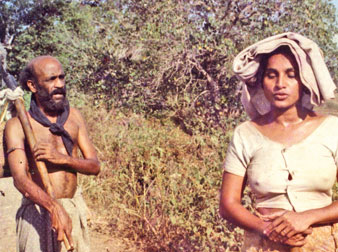|
Sumitra Peries's biography in Sinhala:
Half a century of excellence in cinema
By Ranga CHANDRARATHNE
The manuscript of the biography of Sumitra Peries, Sri Lanka's
pioneer woman filmmaker and one time Sri Lankan ambassador to France was
officially handed over to her in a charm ceremony held at her residence
on her 77th birthday.
 |
|
Sumitra Peries |
 |
|
Ajith Galappaththi |
Sumitra Peries's biography in Sinhala was written by media
personality Ajith Galappaththi and the project was undertaken by S3
organisation which is collaboration among Sangeetha Werarathne, Sudharma
Niththikumara and Shireen Kumaratunga. The biography is published by M.D
Gunasena.
Sumitra as a pioneering woman filmmaker
Sumitra Peries is the path breaking Sri Lankan woman filmmaker who
paved way for the entry of women breaking the monopoly of then male
dominated Sinhalese cinema.
Looking at her remarkable career in cinema which bequeathed the
nation a corpus of creations including Gehenu Lamai (1977), Ganga Adara
( 1980), Yahalu Yeheli (1982), Maya (1984), Sagara Jalaya ( 1988) , Loku
Duwa ( 1996), Duwata Mawak Misa ( 1997- based on novel by G.B
Senanayake) and Sakman Maluwa ( 2003- based on a short story by Godfery
Gunatilake), Sumitra Peries stands out as a Sri Lankan filmmaker who
realistically depicted the Sri Lankan woman from diverse aspects.
The character of woman portrayed in her films is not a prototype or
stereotype woman often valarised by cultural puritans but the one who
plays a dynamic and significant role in life as a mother. For instance,
in her film Duwata Mawak Misa, Sumitra portrays the close relationship
between a mother and a daughter not only in Sri Lanka but also in any
Asian society.
What is noteworthy is that her approach to dealing with
feminist issues is neither sympathetic nor clinical but a realistic one.
Her maturity in the craft was amply demonstrated in Yahaluwo (Best
friends) in 2007. The film was made at the tail end of the conflict and
masterly depicts the dynamics of ethnic relationships among diverse
ethnicities in Sri Lanka through the eyes of a child of mix parentage.
Yahaluwo is so far the most sensible cinematic exploration of diverse
ethnic relations in Sri Lankan polity as the sub-text of the film. At
the same time, it is also a children's film.
Study and exposure
 |
|
A scene from Sagara
Jalaya |
One factor which makes Sumitra Peries is her deep understanding, vast
knowledge and experience in the field of cinema. It was in 1950s that
she studied film making at the London School of Film Technique and
earned a Diploma in Film Direction and Production (1957-1959).
Significantly she was the only woman student at the time and began
working at Mai Harris, a subtitling firm for a short spell.
Sumitra's brother Gamini contacted Lester and checked the possibility
of her sister to work with him.
Lester agreed and Sumitra started the work as assistant director in
his second film Sandesaya. A filmmaking company called Cinelanka was
established in 1963 with Anton Wickramasinghe also Lester and Sumitra as
major shareholders.
Apart from serving the nation in diverse capacities such being a
member of the Presidential Commission for two years to conduct an
inquiry into Sri Lanka's film sector, a member of the Board of
Management of the Institute of Aesthetique Studies, Kelaniya University,
Sri Lanka, Sumitra Peries was the Sri Lanka's Ambassador to France. She
won the award for the best film director in fifty (50) years of Sri
Lankan cinema.
|

